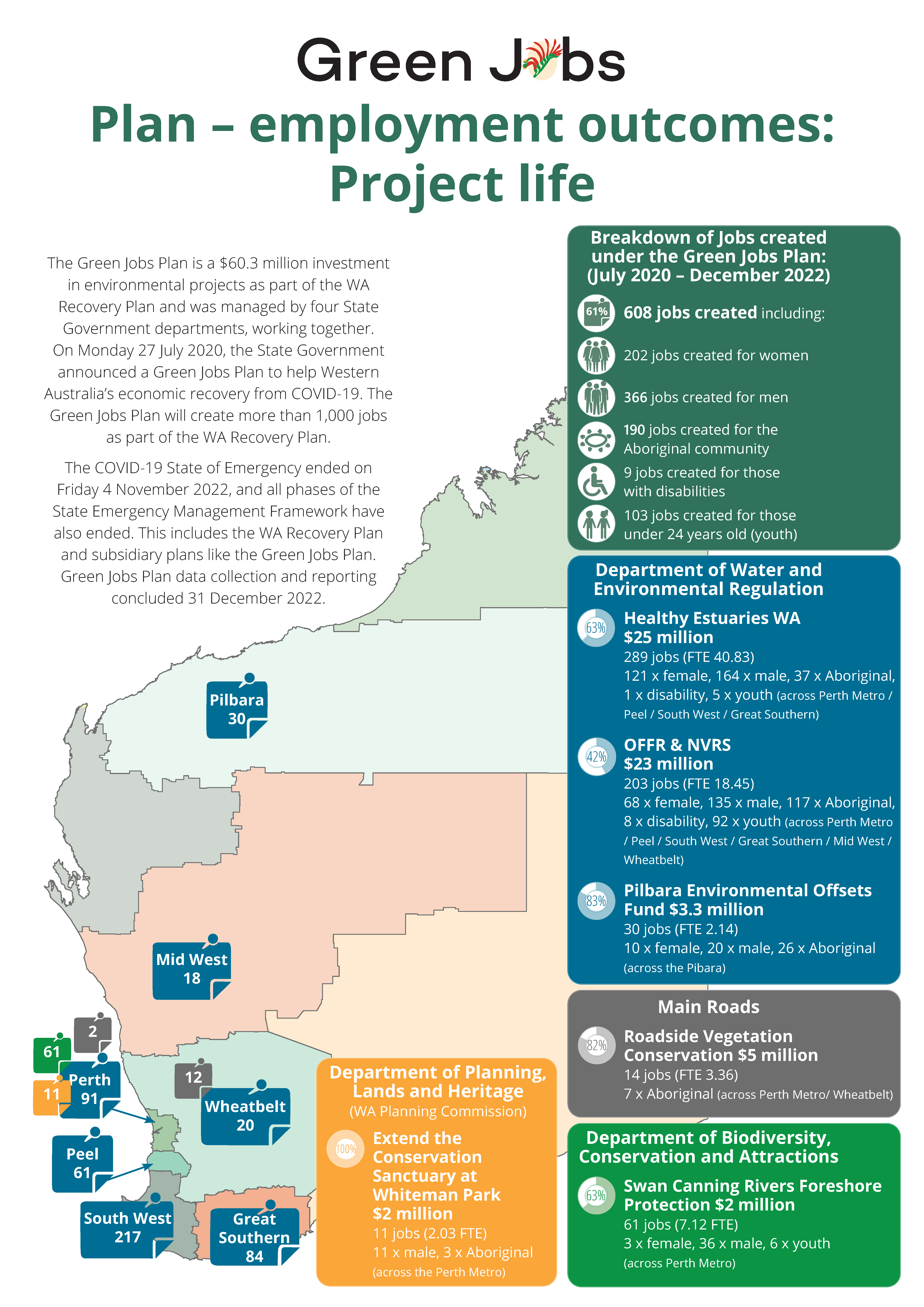On Monday 27 July 2020, the State Government announced a Green Jobs Plan to help Western Australia’s economic recovery from COVID-19. The Green Jobs Plan aimed to create 1,000 jobs as part of the WA Recovery Plan.
The COVID-19 State of Emergency ended on Friday 4 November 2022, and all phases of the State Emergency Management Framework also ended. This included the WA Recovery Plan and subsidiary plans like the Green Jobs Plan. Most of the projects within the Green Jobs Plan have ongoing funding and will continue to operate.
Green Jobs Plan data collection and reporting concluded 31 December 2022, with the overall creation of 608 jobs (more than 60 per cent of the target). Jobs were created predominantly in the not-for-profit sector (46 per cent) and private sector (39 per cent). Employment through Aboriginal organisations accounted for 10 per cent of jobs created since the commencement of the Green Jobs Plan.
Based on the number of jobs created under each program for the last two six-monthly reporting periods, it is projected that the estimated 1,000 jobs should be achieved at the conclusion of the continuing projects.
The Green Jobs Plan was coordinated by the Department of Water and Environmental Regulation (DWER) on behalf of the State Government.
The Green Jobs Plan included:
- $15 million to set up a Native Vegetation Rehabilitation Scheme (DWER)
- $8 million for the Offsets Funds for Recovery program (DWER)
- $2 million to extend the conservation sanctuary at Whiteman Park (Department of Planning, Lands and Heritage)
- $5 million to improve and increase roadside vegetation in the Agricultural region (Main Roads Western Australia)
- $3.3 million for extension of the Pilbara Environmental Offsets Fund (DWER)
- $2 million for foreshore protection along the Swan and Canning River systems (Department of Biodiversity, Conservation and Attractions)
- $25 million for the Healthy Estuaries WA program (DWER).
Projects
Offsets Funds for Recovery and Native Vegetation Rehabilitation Scheme (Environmental Revegetation and Rehabilitation Fund)
DWER is administering funds from the Native Vegetation Rehabilitation Scheme and the Offsets Funds for Recovery program to target restoration of biodiversity values impacted by past clearing through the Environmental Revegetation and Rehabilitation Fund. On-ground works such as fencing, weeding, seeding and planting will create employment opportunities while achieving revegetation, rehabilitation, habitat restoration and protection of existing vegetation. These projects will continue until the end of June 2026.
If you own or manage land that you would like to have revegetated, please contact the DWER’s COVID Recovery project team.
Healthy Estuaries WA
DWER is continuing to work with the community to improve the condition of at-risk regional estuaries in the south-west of Western Australia through the $25 million Healthy Estuaries WA program.
You can read about how Healthy Estuaries WA has supported jobs for 69 people in regional areas since the program started in 2020. This project will continue until the end of June 2024.
Pilbara Environmental Offsets Fund extension
$3.3 million in funding from the Pilbara Environmental Offsets Fund has been made available through DWER to enable Aboriginal and conservation groups to undertake conservation work in the Pilbara. The extension component of this project will continue until the end of June 2023, and the project will continue beyond this with its base funding level, derived from proponent contributions.
Whiteman Park conservation fencing – delivered
The Department of Planning, Lands and Heritage (DPLH) invested $2 million to extend the fauna fencing around Whiteman Park, and the electrified feral animal exclusion fence around the Woodland Conservation Reserve inside Whiteman Park. Both projects were completed in 2021.
Roadside vegetation conservation
Main Roads WA is investing $5 million towards enhancing roadside vegetation corridors, widening road reserves and replanting vegetation through the Wheatbelt. This project will continue until the end of June 2025.
Swan Canning rivers foreshore protection
The Department of Biodiversity, Conservation and Attractions (DBCA) is investing an additional $2 million to enhance foreshore protection measures in the Swan and Canning River systems. The extension component of this project is complete, and the project is continuing with its base funding level. This project will continue until the end of June 2024.



